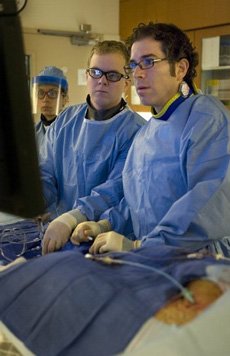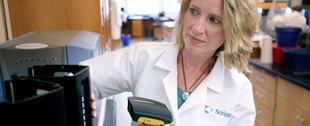Home » Translational Research » Research Highlights » Heart Disease » Here
In this section
Cardiovascular pharmacogenomics
Testing for genetic modifiers of clopidogrel response:
A prototype for individualized medicine
 Matthew J. Price, M.D., performs an angioplasty-stent procedure at Scripps Green Hospital. Dr. Price, a Scripps Health interventional cardiologist, is one of the Scripps Translational Science Institute researchers who are conducting cardio-pharmacogenomics studies relevant to anti-platelet therapy for patients undergoing angioplasty-stent procedures.
Matthew J. Price, M.D., performs an angioplasty-stent procedure at Scripps Green Hospital. Dr. Price, a Scripps Health interventional cardiologist, is one of the Scripps Translational Science Institute researchers who are conducting cardio-pharmacogenomics studies relevant to anti-platelet therapy for patients undergoing angioplasty-stent procedures.
Scripps Green Hospital in La Jolla, CA, was the first medical center in the U.S. to adopt genotyping for cardiac patients undergoing angioplasty and stent procedures.The test, which determines whether the patient’s DNA includes a genetic variant of CYP2C19 as a heterozygous allele or as homozygous alleles, was inspired by the results of a Scripps Translational Science Institute pilot research study.
In March 2010, the U.S. Food and Drug Administration (FDA) added a warning to the clopidogrel prescription label to call attention to the risk of heart attack, stroke and other cardiovascular events in patients who have one of the CYP2C19 gene variants. Clopidogrel, the second most highly prescribed medicine in the U.S., and aspirin are the cornerstone of anti-platelet therapy in patients undergoing angioplasty/stent procedures.
CYP2C19 testing represents an individualized approach to medical care that could prevent tens of thousands of adverse cardiovascular events in the over 30% of those with European ancestry and over 40% of those with Asian or African ancestry who have one of the four genetic variations, wrote Samir B. Damani, M.D., and Eric J. Topol, M.D., of STSI and Scripps Health, in a Journal of the American College of Cardiology essay.
STSI researchers have continued to study clopidogrel’s pharmacogenomics. In early Nov. 2010, the Journal of the American College of Cardiology published the results of a STSI longitudinal, observational investigation of the safety and effectiveness of doubling the dosage of clopidogrel from the standard 75 mg/day with aspirin to 150 mg/day in 41 patients with identified CYP2CI9 variants. They also had high platelet reactivity, according to a point-of-care test administered at the Scripps Clinic, where the patients underwent the angioplasty and stent procedures.
The research team, headed by Matthew J. Price, M.D., Director of Interventional Cardiology at Scripps Clinic and Assistant Professor at STSI, found that doubling the dosage significantly reduced cardiac patients’ platelet reactivity, a measure of the blood cells’ “stickiness” or tendency to clump together to form the blood clots that can obstruct arteries and blood vessels. The higher dosage of clopidogrel “normalized” reactivity in 56% of the 41 patients in the study. The median duration of clopidogrel therapy was eight days.
A total of 20 of the 41 patients had the gene variant that impedes clopidogrel metabolism, while the CYP2C19 variant of the remaining 21 patients qualified them as “ultra-rapid or extensive metabolizers” of the drug.
However, during treatment with the 150 mg/day dosage, the patients’ platelet reactivity was not significantly influenced by whether they had the CYP2C19 variant that impedes metabolism or the variant connected with “ultra-rapid” metabolism of clopidogrel.
“The incremental inhibition provided by the higher dosage is largely similar regardless of the patients’ CYP2C19 status,” Dr. Price and his research colleagues wrote in their journal report.
However, in the small number of patients homozygous for CYP2C19, the effect of 150-mg/day was less clear, and the authors noted that the incremental inhibition with higher dose therapy in this group of the patients deserves additional study.
Body mass index (BMI) was the only characteristic independently associated with a change in platelet reactivity with high-dose clopidogrel therapy. The researchers note that the patients’ BMI may have limited the effectiveness of doubling the dosage. “…our findings question whether even an increased dosage can achieve adequate levels of platelet inhibition in obese patients” with high reactivity, they wrote in the journal report.
The researchers also found that high platelet reactivity during the standard 75 mg/day clopidogrel dosing was independently predictive of persistently high platelet reactivity when the dosage is doubled to 150 mg/day.
The Scripps Translational Science Institute research team that conducted this study included Eric Topol, M.D., Sarah S. Murray, Ph.D., Paul S. Teirstein, M.D., David E. Kandzari and Matthew J. Price, M.D. Drs. Topol, Teirstein, Kandzari and Price also are faculty members and physicians at Scripps Clinic. The first author of the paper, Colin M. Barker, M.D., is now based at the University of Texas Medical School in Houston.
For more information:
- Pilot study of the antiplatelet effect of increased clopidogrel maintenance dosing and its relationship to CYP2C19 genotype in patients with high on-treatment reactivity. Barker CM, Murray SS, Teirstein PS, et al. JACC Cardiovasc Interv 2010.3:1001-1007.
- “The Case for Routine Genotyping in Dual-Antiplatelet Therapy,” Journal of the American College of Cardiology, May 12, 2010
- High-Dose Use of Antiplatelet Drug after Stent Placement Does Not Reduce Risk Of Heart Attack, Death, For Certain Patients.” Medical News Today. March 15, 2011
